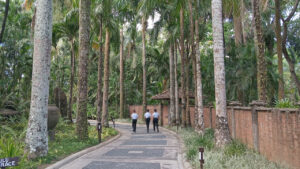An ounce of prevention

Focusing on wellness at The Farm at San Benito
By Victoria M. Fritz
TAKE it from me. Wellness is cheaper than sickness.
A year ago, I was scrimping on healthy food to save money for something. Then I got a serious stomach illness and spent a fortune being hospitalized for a few days.
Wellness programs may seem expensive, but they are still cheaper than a hospital stay and prescription drugs. Need I say they’re a lot more enjoyable and effective in the long term?
A recent stay in The Farm at San Benito getting all my favorite treatments cost less than my hospital “staycation.” And I felt more revitalized afterward.
Days before I got to The Farm, I filled out a detailed questionnaire on my state of health and what I’d like to achieve. Armed with this info, the staff came up with a treatment program and diet.
I got there on a Monday, in time for a vegan lunch. Forget all the bad rap vegan food gets, it was pretty good — a surprising and delightful pureed corn soup and an eggplant lasagna meal capped with the most intense chocolate pecan pie for dessert. I asked for another glass of their welcome drink — a refreshing and invigorating mix of coconut juice with lime and ternate. I would ask for a glass every day that I stayed there.I consulted briefly with The Farm’s Dr. Mark Tarronas, who reviewed my medical history and tweaked my program accordingly.
Before my next consultation, I snuck out for a swim at the infinity pool in the Healing Sanctuary.
Everything became quiet inside once I was immersed in the natural pool, which had a mesmerizing reflection of the surrounding pine trees.
Then I enjoyed a Monet-like view of trees, this time at the office of Jeanne Bruce, the in-house nutritionist, who tailor-made a blood type diet for me. It’s not a cookie-cutter type O+ (my blood type) diet, but one based on my medical history as well. I was tempted to share it with my family back home (we’re all type O +), but she said, no, that’s only for you.Now I was ready for my first treatment at The Farm — the Purification treatment at the Healing Sanctuary (a.k.a. the spa).
As Jessa gave me a scrub and light massage using coconut oil and sea salt, this thought really crossed my mind,
“I must have died and gone to heaven.”
After 90 divine minutes, she led me to an outdoor shower completely surrounded by trees and right under the stars. It was an unforgettable experience.
All these took a while so dinner was a bit late. No worries, it was going to be a light one.
PRANAThat’s the name of the vegetarian/Ayurvedic restaurant. They were mindful of my sensitive stomach and served food that was not spicy or acidic. Cauliflower bites, Red lentil soup (which was actually yellow, let supervisor Peng explain why), and vegetable biryani.
In the morning, breakfast had to be extra light as I was undergoing the Colema treatment. This is a more convenient and pleasant form of enema. Due to my sensitive stomach, I was given chamomile instead of the usual coffee enema. Head nurse Cleo chatted with me throughout the process and told me stories about The Farm. It was done in no time.Lunch was a fern salad and beetroot ravioli, the latter made using cashew cheese. I ate every morsel. How often will I get access to certified organic vegetables? Apropos of a place called The Farm, they grow most of the vegetables they serve right here.
I also got a bite of their vegan Carbonara. I didn’t miss the bacon or egg.
AQUA THERAPYIn the early afternoon, I went through a buffet of water therapies. The first stop was an onsen. At 39 degrees, it was akin to the real thing. Then one walks to a jacuzzi, and onto rings of water jets that massage your head and upper body. This could be a lot of fun if you like playing in the water.
Below were four tubs that emitted different types and strengths of streaming water, massaging different parts of your body. After the massage, I went into a flotation pod. The water has Epsom salt, which will keep you afloat even if you try to sink yourself. After a few minutes, I fell asleep and felt I was lying on something solid.
The final treatment of the day was another type of detox — the Vital Dome. It’s like a sauna, but is shaped like an MRI machine. I was a bit tired, so I opted for the lowest temperature level, 45C — called Relaxation. I hardly broke a sweat and just meditated. A nice lady who went just before I did had used the next level, 65C, called Detoxification, and she felt so light and revitalized after, she said. The highest level, 80C, is usually chosen by athletes who have a lot of muscle soreness. This machine uses far infrared to regenerate the body from within, so it can heal as well.
Having relaxed to the max, I had a very restful sleep.
The next morning was Step 2 of my stomach detox, the step called Angel of Water. It uses plain water but a higher volume to reach the upper tract. It took just a little bit longer to do than the Colema, but this is when I really felt clean, light, and revitalized afterward.
ALIVEI finally got to have my leisurely breakfast day. Breakfast is always at Alive, the vegan restaurant. There is a selection of homegrown fruits, a choice of mango or coconut yogurt (I always have both), salads, bread, and cereals. Then I moved on to empanada and sayote soup, a nice combination that was comforting to my stomach.
I had enough time to rest before my next treatment.
MYOTHERAPYIf there are two medical treatments I would recommend to most people, it would be the Colema (the colon cleanse) and the myotherapy. But myotherapy is my favorite. It’s a scientific and deep muscle massage that really loosens long atrophied tissue from years of sitting in one position at work, or watching TV, etc..
I thought I had minimal soreness in the neck and upper back. Jo, the myotherapist, examined me and said some parts were “hard as stone” already. She expertly loosened some deep muscles I wasn’t even aware of. In the end, she taught me some easy stretches to do daily. It’s not a one-time fix. Jo did step one, and I have to stretch regularly to continue loosening the muscles. Regular masseurs like to force loosen our knots in one go which can cause bruises. It’s also not the right way to get the job done. For days after, I felt a pleasant type of soreness as my muscles continued to loosen.
PESCEMy last meal was at the only restaurant at The Farm that serves seafood, the aptly named Pesce. The seafood ginger soup had a strong yet refreshing flavor. I also had tuna adobo, flavored with oyster sauce. The bestseller dessert is the tiramisu. Even without liqueur, it was worth it.
Aside from my stomach issues, my main goal was to destress and address my anxiety. My final activity at The Farm was a consultation with the head of the Holistic Center, Dr. Marian Alonzo, an anthroposophic doctor. We had a short calming session where she taught me tapping and the Sa Ta Na Ma meditation. Days later I am still using tapping to address my anxiety.
I learned my lesson well. No scrimping on wellness.
Five tips towards self-care
MANY people consider self-care as a luxury rather than a priority, which leaves them feeling exhausted, overwhelmed, and unprepared to handle day-to-day challenges.
Wellness coach, workshop leader and health educator Elizabeth Scott, PhD, explained that self-care is about more than finding ways to relax. It focuses more on addressing the basic needs of the body.
“All the stress relief activities in the world won’t help if you aren’t taking care of yourself,” she stated. “Meditation won’t do you any good if you aren’t getting adequate sleep. Hitting the gym once in a while won’t relieve much if you’re not regularly fueling your body with healthy, nutrient-dense food.”
Ms. Scott, author of The 8 Keys to Stress Management, who specializes in positive psychology, healthy relationships, and emotional well-being, likewise elaborated that it is not a “one size fits all strategy.”
“The demands of your daily life can dictate what you need most. Your self-care plan needs to be customized to what is currently going on in your life,” she noted. “You don’t want to wait until you’ve reached your breaking point.”
Echoing the expert, the Benilde Well-Being Center of the De La Salle-College of Saint Benilde shared Scott’s advice and the different types of self-care to guide the general public in restoring their balance and finding relief from stressors.
“Schedule time to focus on yourself,” Ms. Scott concluded. “Even when you feel like you don’t have time to squeeze in one more thing, make self-care a priority. When you’re caring for all aspects of yourself, you’ll find that you are able to operate more effectively and efficiently.”
Here are five reminders on how to best take care of ourselves:
1. Physical. Take care of your body if you want it to run efficiently. You will think and feel better, too. Get adequate sleep. Have enough exercise. Eat a balanced diet. Take charge of your health. Attend appointments. Take medications as prescribed.
2. Social. Put time and energy in cultivating and maintaining close connections. Create an optimal social life. Nurture relationships with peers and family. Get enough face-to-face time with them.
3. Mental. Keep your mind sharp. Engage in activities that mentally stimulate you. Answer some puzzles. Learn about a subject that fascinates you. Read books. Watch movies that inspire you. Maintain a healthier inner dialogue. Practice self-compassion and acceptance.
4. Spiritual. Nurturing your spirit doesn’t have to involve religion. Meditate. Pray. Attend a religious service. Develop a deeper sense of meaning, understanding, or connection with the universe.
5. Emotional. Allot time for tasks that aid you to acknowledge and express your feelings regularly and safely. Immerse yourself in leisure activities that help you process your emotions and recharge. Talk to a partner, a friend, or family about how you feel.
An additional tip: customize your own self-care plan. This can serve as a preventative measure to make sure that you don’t get overwhelmed. Make a list of the different aspects of your life. List down major daily activities. Assess your needs. Think about the possible stressors. Consider the things you can do to address it or help yourself feel better. Prepare for possible challenges. Identify a single small step to start caring for yourself.




